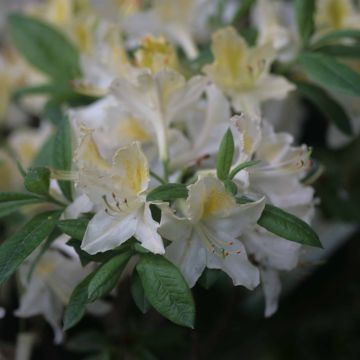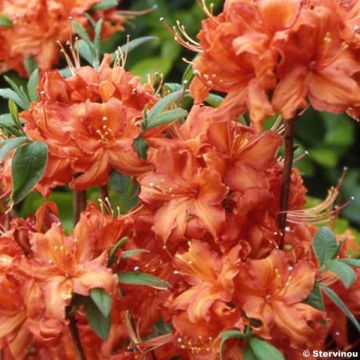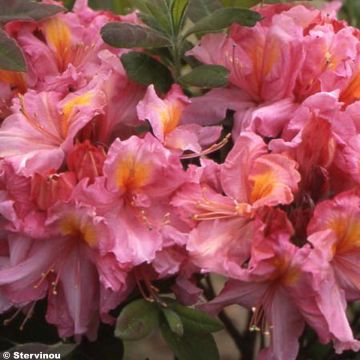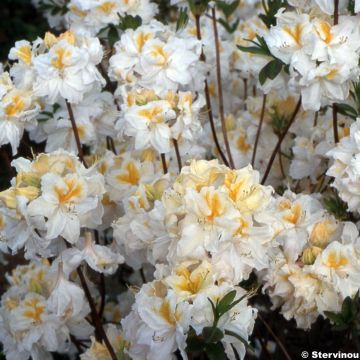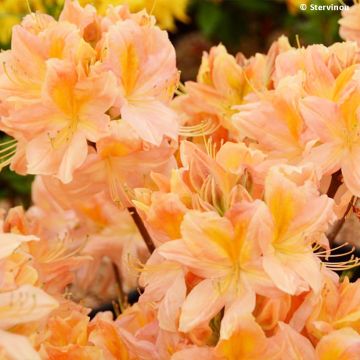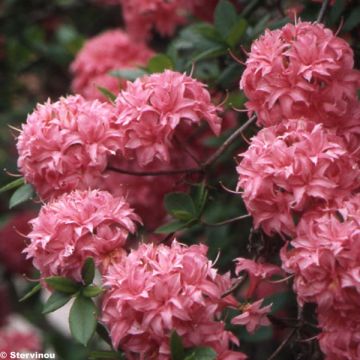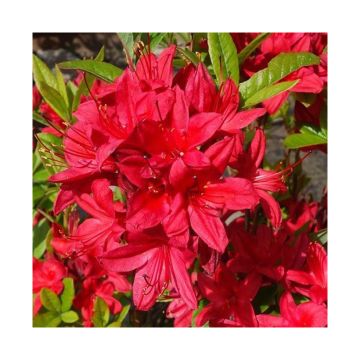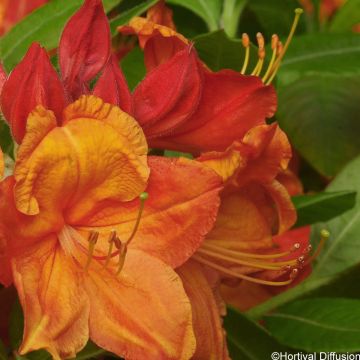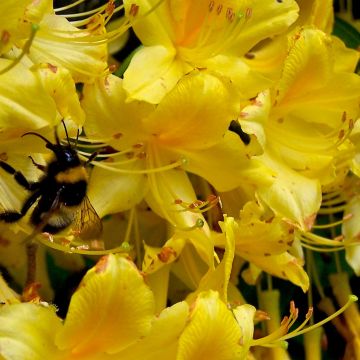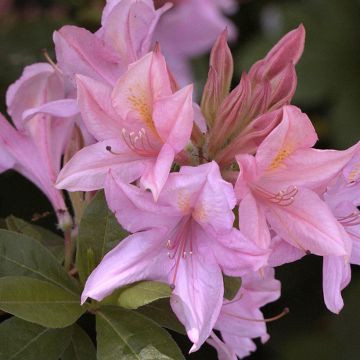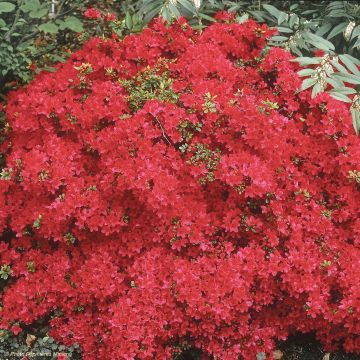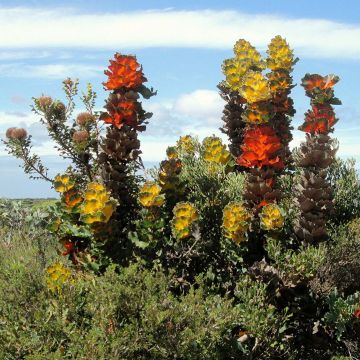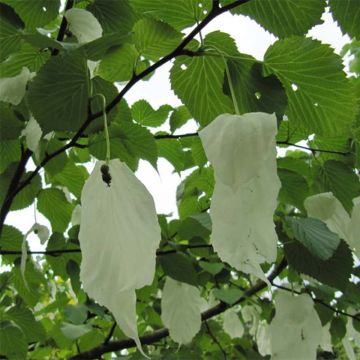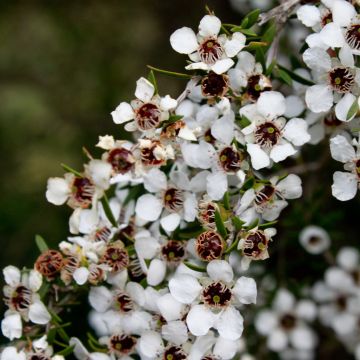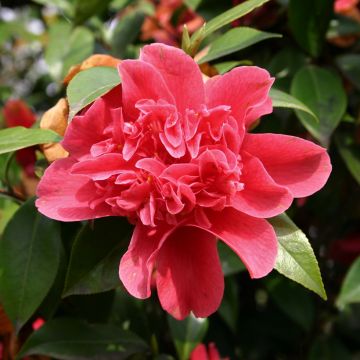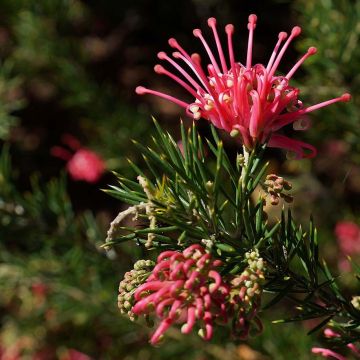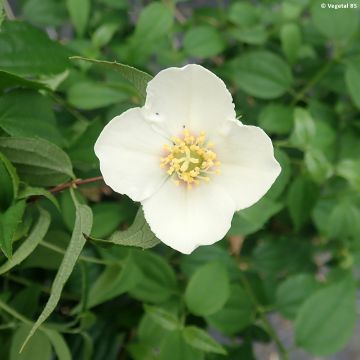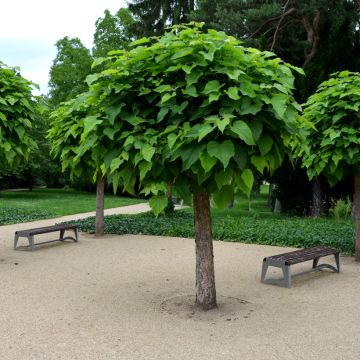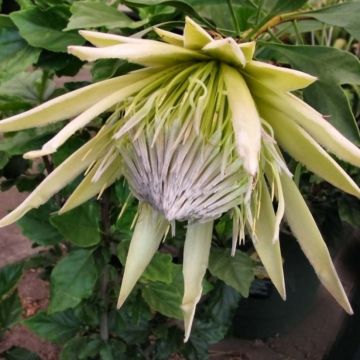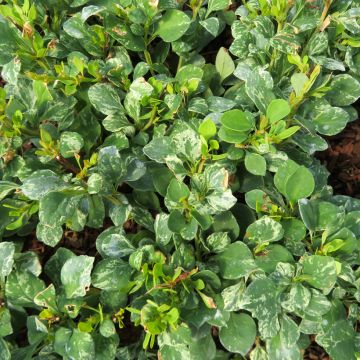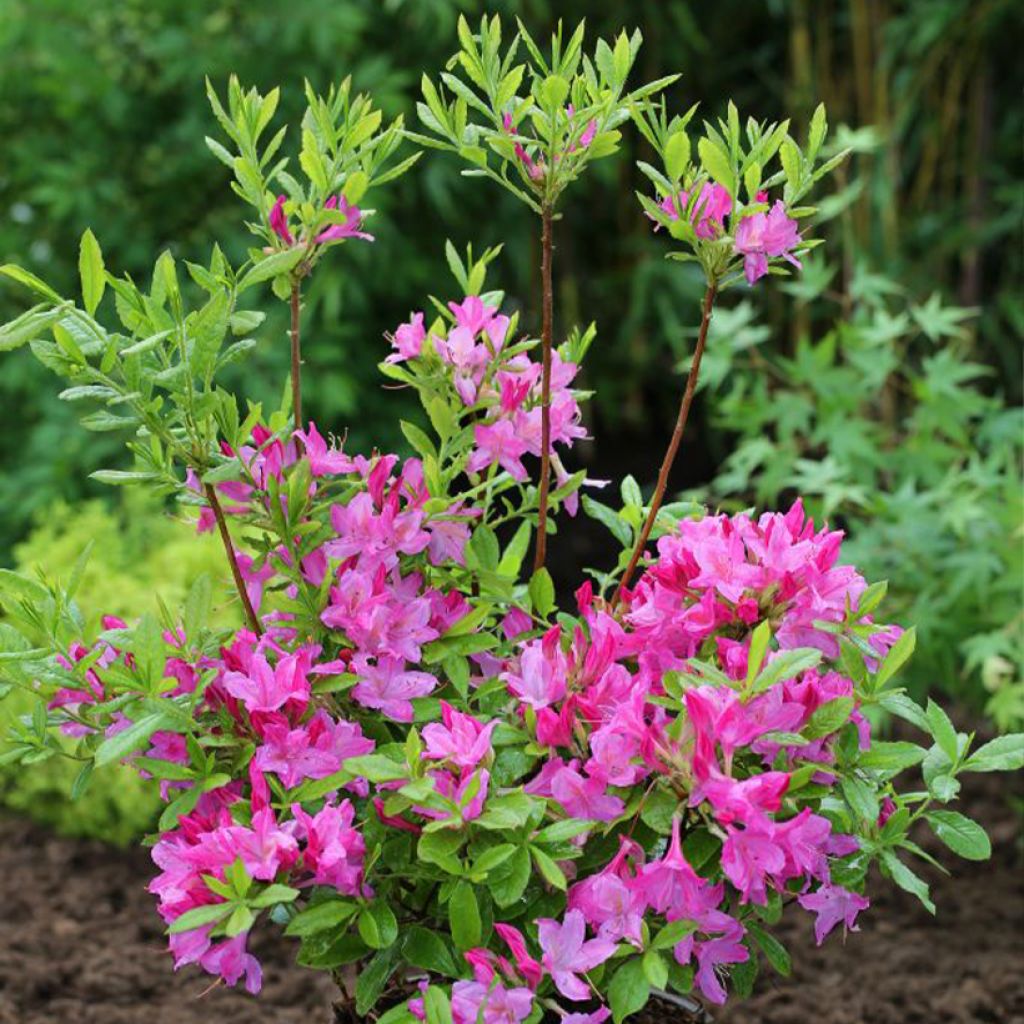

Rhododendron Fraseri
Rhododendron Fraseri
Rhododendron (Azalea) Fraseri
This item cannot be shipped to the selected country
Delivery charge from €5.90
More information
Schedule delivery date,
and select date in basket
This plant carries a 24 months recovery warranty
More information
We guarantee the quality of our plants for a full growing cycle, and will replace at our expense any plant that fails to recover under normal climatic and planting conditions.
From €5.90 for pickup delivery and €6.90 for home delivery
Express home delivery from €8.90.
Does this plant fit my garden?
Set up your Plantfit profile →
Description
Rhododendron 'Fraseri' is a hybrid variety of Chinese azalea, resulting from cross-breeding between two species. It forms a medium-sized bush with deciduous light green foliage. In spring, numerous clusters of flowers appear in vibrant colours, ranging from pink to mauve-lilac. Its foliage often takes on beautiful warm colours in autumn. This beautiful bush is easy to grow. It tolerates non-burning sun and appreciates moist, humus-bearing, non-calcareous soil. This very hardy plant can be grown in many regions.
Azalea is a horticultural term still commonly used, but in botanical terms, azaleas are rhododendrons, with flowers that have 5 stamens instead of 10. They belong to the Ericaceae family, just like heathers, strawberry trees, and blueberries. They mostly prefer soils with an acidic tendency, devoid of limestone. They also like humid climates. Deciduous Chinese azaleas have less requirements than evergreen Japanese azaleas. They are quite hardy, tolerate sunny exposures and heat, and can even withstand occasionally dry soil (depending on the hybrids). Nevertheless, they give their best in cool climates with marked winters, planted in humus-bearing and fertile soil without limestone
'Fraseri' is a hybrid resulting from cross-breeding between Rhododendron canadense, a small Canadian botanical species with violet flowers and remarkable hardiness (-32°C (-25.6°F)), and R. molle subsp. japonicum, the well-known Azalea mollis. 'Fraseri' reaches a height of about 90cm (35in) and a width of 1.2m (4ft) in 10 years. At maturity, it reaches a height of 1.2m (4ft) with a spread of 1.5m (5ft). This compact bush starts flowering towards the end of April, before the first leaves emerge. It produces pretty flowers of about 4cm (2in) in diameter, formed by 5 elongated petals, with a colour somewhere between violet-pink and mauve-lilac. The flowers are gathered in large clusters at the ends of thin branches, and tend to turn more violet as the flowering progresses. The upper petal is punctuated with spots of dark purple, and a bouquet of stamens gracefully arched upwards emerges from the centre of the corolla. The flowers bloom for approximately 3 weeks, and are soon joined by the young leaves. These tender green leaves, measuring from 6 to 10cm (2 to 4in) in length, have an elongated lanceolate shape and weave through the flowers in May. In autumn, they generally take on beautiful warm shades of yellow-orange, before falling to the ground.
This bush tolerates the sun. However, it will fare better in hot climates if planted under light shade, as it does not like drought or excessively burning rays. It will also require some soil moisture in summer, so watering may be needed. It grows in humus-bearing, neutral to acidic soil that is not calcareous. While it appreciates moisture and even humidity, the soil must still be well-drained. This hybrid has inherited very good hardiness from its Canadian parent, thus being able to withstand frosts as low as -25°C (-13°F).
'Fraseri' is a graceful variety. It has a romantic charm and vibrant flowering that catches the eye in spring. You can plant it with other bushes that share the same needs and have staggered flowering periods to create an ornamental bed all year round. Stachyurus praecox will open the season in February-March with its string-like yellow bell-shaped flowers, and will end the season with its flamboyant red autumn foliage. To take over, the surprising Magnolia acuminata 'Blue Baby' will delight you with its large floral buds of a rare blue colour, which will open to reveal beautiful yellow flowers. For summer blooms, choose from the countless varieties of hydrangeas. Finally, nothing beats an autumn camellia in pink, red, or white to close the season.
Report an error about the product description
Plant habit
Flowering
Foliage
Botanical data
Rhododendron (Azalea)
Fraseri
Ericaceae
Cultivar or hybrid
Other Chinese Azalea
Planting and care
It enjoys a sunny location, but its preferred exposure is partial shade or morning sun, especially in hot regions. Plant it in neutral or slightly acidic, humus-bearing soil. It grows well in rich and humus-bearing soil that is moist or even wet (but still well-drained) without drying out in summer
Soak the root ball in a bucket for fifteen minutes to ensure it is well-watered. When planting, the top of the root ball should be level with the existing ground. Water abundantly during dry periods, at least once a week during the first year. Apply fertiliser in spring. After flowering, lightly prune to maintain a tidy plant, although pruning is not essential. Remove faded flowers to extend the flowering period.
It is not prone to many diseases when properly established outdoors. It can be attacked by weevils that eat the edges of the leaves and rootlets, as well as by the famous "rhododendron beetle" which rarely causes significant damage. If the soil is chalky or poorly drained, and if the plant is planted too deeply, the leaves may turn yellow.
Planting period
Intended location
Care
This item has not been reviewed yet - be the first to leave a review about it.
Spring-flowering shrubs
Haven't found what you were looking for?
Hardiness is the lowest winter temperature a plant can endure without suffering serious damage or even dying. However, hardiness is affected by location (a sheltered area, such as a patio), protection (winter cover) and soil type (hardiness is improved by well-drained soil).

Photo Sharing Terms & Conditions
In order to encourage gardeners to interact and share their experiences, Promesse de fleurs offers various media enabling content to be uploaded onto its Site - in particular via the ‘Photo sharing’ module.
The User agrees to refrain from:
- Posting any content that is illegal, prejudicial, insulting, racist, inciteful to hatred, revisionist, contrary to public decency, that infringes on privacy or on the privacy rights of third parties, in particular the publicity rights of persons and goods, intellectual property rights, or the right to privacy.
- Submitting content on behalf of a third party;
- Impersonate the identity of a third party and/or publish any personal information about a third party;
In general, the User undertakes to refrain from any unethical behaviour.
All Content (in particular text, comments, files, images, photos, videos, creative works, etc.), which may be subject to property or intellectual property rights, image or other private rights, shall remain the property of the User, subject to the limited rights granted by the terms of the licence granted by Promesse de fleurs as stated below. Users are at liberty to publish or not to publish such Content on the Site, notably via the ‘Photo Sharing’ facility, and accept that this Content shall be made public and freely accessible, notably on the Internet.
Users further acknowledge, undertake to have ,and guarantee that they hold all necessary rights and permissions to publish such material on the Site, in particular with regard to the legislation in force pertaining to any privacy, property, intellectual property, image, or contractual rights, or rights of any other nature. By publishing such Content on the Site, Users acknowledge accepting full liability as publishers of the Content within the meaning of the law, and grant Promesse de fleurs, free of charge, an inclusive, worldwide licence for the said Content for the entire duration of its publication, including all reproduction, representation, up/downloading, displaying, performing, transmission, and storage rights.
Users also grant permission for their name to be linked to the Content and accept that this link may not always be made available.
By engaging in posting material, Users consent to their Content becoming automatically accessible on the Internet, in particular on other sites and/or blogs and/or web pages of the Promesse de fleurs site, including in particular social pages and the Promesse de fleurs catalogue.
Users may secure the removal of entrusted content free of charge by issuing a simple request via our contact form.
The flowering period indicated on our website applies to countries and regions located in USDA zone 8 (France, the United Kingdom, Ireland, the Netherlands, etc.)
It will vary according to where you live:
- In zones 9 to 10 (Italy, Spain, Greece, etc.), flowering will occur about 2 to 4 weeks earlier.
- In zones 6 to 7 (Germany, Poland, Slovenia, and lower mountainous regions), flowering will be delayed by 2 to 3 weeks.
- In zone 5 (Central Europe, Scandinavia), blooming will be delayed by 3 to 5 weeks.
In temperate climates, pruning of spring-flowering shrubs (forsythia, spireas, etc.) should be done just after flowering.
Pruning of summer-flowering shrubs (Indian Lilac, Perovskia, etc.) can be done in winter or spring.
In cold regions as well as with frost-sensitive plants, avoid pruning too early when severe frosts may still occur.
The planting period indicated on our website applies to countries and regions located in USDA zone 8 (France, United Kingdom, Ireland, Netherlands).
It will vary according to where you live:
- In Mediterranean zones (Marseille, Madrid, Milan, etc.), autumn and winter are the best planting periods.
- In continental zones (Strasbourg, Munich, Vienna, etc.), delay planting by 2 to 3 weeks in spring and bring it forward by 2 to 4 weeks in autumn.
- In mountainous regions (the Alps, Pyrenees, Carpathians, etc.), it is best to plant in late spring (May-June) or late summer (August-September).
The harvesting period indicated on our website applies to countries and regions in USDA zone 8 (France, England, Ireland, the Netherlands).
In colder areas (Scandinavia, Poland, Austria...) fruit and vegetable harvests are likely to be delayed by 3-4 weeks.
In warmer areas (Italy, Spain, Greece, etc.), harvesting will probably take place earlier, depending on weather conditions.
The sowing periods indicated on our website apply to countries and regions within USDA Zone 8 (France, UK, Ireland, Netherlands).
In colder areas (Scandinavia, Poland, Austria...), delay any outdoor sowing by 3-4 weeks, or sow under glass.
In warmer climes (Italy, Spain, Greece, etc.), bring outdoor sowing forward by a few weeks.

































